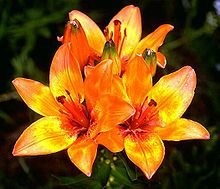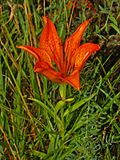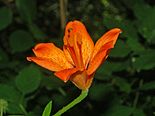- Lilium bulbiferum
-
Lilium bulbiferum 
Scientific classification Kingdom: Plantae (unranked): Angiosperms (unranked): Monocots Order: Liliales Family: Liliaceae Genus: Lilium Species: L. bulbiferum Binomial name Lilium bulbiferum
L., 1753Synonyms - Lilium chaixii Maw
- Lilium aurantiacum Weston
- Lilium croceum Chaix
- Lilium pubescens Bernh. ex Hornem.
- Lilium humile Mill., 1768
- Lilium scabrum Moench, 1794
- Lilium aurantiacum Weston, 1771
- Lilium luteum Gaterau, 1789
Lilium bulbiferum, common names Orange Lily, Fire Lily or Tiger Lily, is a herbaceous perennial plant with underground bulbs, belonging to the genus Liliums of the Liliaceae family. The Latin name bulbiferum of this species, meaning "bearing bulbs", refers to the secondary bulbs on the stem.
Contents
Description
Lilium bulbiferum reaches on average 20–90 centimetres (7.9–35 in) of height, with a maximum of {{convert|120|cm}. The bulbs are ovoid, with whitish large and pointed scales and can reach about 1.5 centimetres (0.59 in) of diameter. The stem is erect, the leaves are lanceolate, up to 10 centimeters long. The inflorescence has one to five short-haired flowers. They are hermaphroditic and scentless, have six upright tepals, the outer are slightly narrower than the inner ones. The flowers can reach 4-6 centimeters in length and are bright yellow-orange with reddish-brown dots. The stamens are erect, about half as long as the tepals, with red anthers. The style is orange, 35 millimetres (1.4 in) of height. The flowering period extends from May through July.
There are two main subspecies, Lilium bulbiferum croceum (Chaix) Baker and Lilium bulbiferum bulbiferum. Only the last one produces always secondary aerial bulbs (bulbils) in the axils of the upper leaves. These bulbils fall to the ground and mature after two to three years. When manually separated from the stem they can easily used for propagating the plant.
Gallery
Distribution
This species is common in the mountains of central and southern Europe from the Pyrenees up to the northern Balkans.
Habitat
These plants grow in mountain meadows and rocks. They prefer calcareous soils in warm, sunny places, but also grows on slightly acid soils. They can be found at an altitude of 500–1,900 metres (1,600–6,200 ft) above sea level.
In culture
The Orange Lily has long been recognised as a symbol of the Orange Order in Northern Ireland. In Hanakotoba (花言葉, flower-language), the Japanese language of flowers, the orange lily symbolizes hatred or revenge when given as a gift.
References
- Pignatti S. - Flora d'Italia - Edagricole – 1982 Vol. III. pa. 362
- Sugizo, Obata (2006-10-10) - "Meaning of Japanese Flowers"
- Orange Order Symbol
External links
This Liliales article is a stub. You can help Wikipedia by expanding it.





